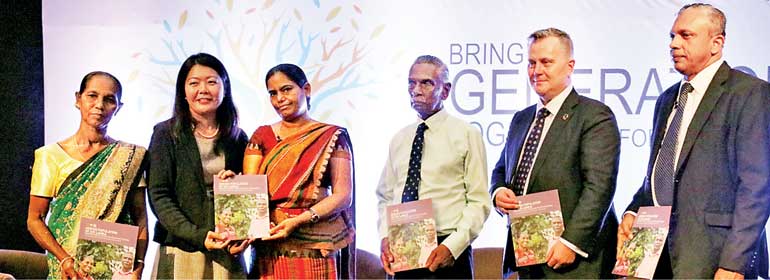Friday Apr 18, 2025
Friday Apr 18, 2025
Monday, 16 October 2017 00:00 - - {{hitsCtrl.values.hits}}
By Shannon Jayawardena
The United Nations Population Fund (UNFPA), in partnership with the Department of Census and Statistics (DCS), recently held its fourth Intergenerational Dialogue on the theme ‘Ageing Population in Sri Lanka and its policy Implications’, highlighting the positives and negatives of the demographic challenge.

Sri Lanka's ageing population has shown a significant increase, making the country the home for the largest elderly population in South Asia, with 12.4% of the country’s citizens being classified as belonging to the aged population, those who are of the age of 60 and above, in 2012, up from 6.6% in 1981.
However, it was emphasised that the ageing population poses both challenges and positive outcomes as it was a central point of a country’s economic growth. It is evident that this does pose challenges with problems such as pressure on healthcare services and the risk of immense poverty among the majority. However, they are a great resource and achievement of the country for they show the development of the country as a whole.
Department of Census and Statistics, Director General Dr. A.J. Satharasinghe, delivering a presentation on the current status, said that the growth of the aging population was a result of the increase of the life expectancy rate at birth as well as its effect on the literacy rate which has risen to a total of 96.9%. He also stated: “According to the 2012 Population and Housing Census, life expectancy of males is 72 and females is 79 years.”
“We need to ensure that the country is ready for this demographic shift.”
The elderly population is divided into three subcategories, which are the young old (60-69) who consist of 61% of the aged population, the middle old (70-79) who comprise 28% and the oldest old (80 and above) who constitute only 11% of the aged population. Therefore as the elderly population increases, it is very important for the awareness of the public for they too make an enormous contribution towards sustainable development and economic growth.
UNFPA Regional Director for Asia Pacific Bjorn Anderson in his keynote address said: “The UNFPA is committed to being part of the effort to ensure that the discourse on ageing shifts away from focusing on the cost and burden of ageing.”
He added that the population has recently seen the most significant shift in Asia Pacific and this should be regarded as an achievement rather than a burden. The increase of the aged population demonstrates better living standards, happier, healthier and fruitful lives, which thereby should be looked upon as an asset and example of the prosperous living standards of the people.
The UN Sustainable Development Goals also portray a key role in the awareness and betterment of the aged population, for their sole aim is improve the lives of men and women of all ages, ensuring that no one is left behind. Their goal number 3 is to shelter healthy lives for all age groups, including the whole of the elderly population varying from the young old to the oldest old.
The presentation also displayed that over half of the aged population experiences physical and mental impairment; 21.8% seeing, 19.4% walking, 11.3% hearing, 8.3% related to cognition, while three-fourths of the population were economically inactive. Hence, although the number of the aged increases, this population faces crucial difficulties in life and therefore needs to be attended to through a more holistic approach.
Highlighting the importance of seeing ageing as a triumph of development, as an asset rather than burden, UNFPA representative in Sri Lanka, Ritsu Nacken said: “People are living longer because of better nutrition, sanitation, healthcare, education and economic wellbeing. Although an ageing world poses social and economic challenges, the right set of policies can equip individuals, families and societies to address these challenges and reap its benefits.”

The Thematic Report on Population Ageing in Sri Lanka, jointly published by UNFPA and DCS, is officially disseminated
Discover Kapruka, the leading online shopping platform in Sri Lanka, where you can conveniently send Gifts and Flowers to your loved ones for any event including Valentine ’s Day. Explore a wide range of popular Shopping Categories on Kapruka, including Toys, Groceries, Electronics, Birthday Cakes, Fruits, Chocolates, Flower Bouquets, Clothing, Watches, Lingerie, Gift Sets and Jewellery. Also if you’re interested in selling with Kapruka, Partner Central by Kapruka is the best solution to start with. Moreover, through Kapruka Global Shop, you can also enjoy the convenience of purchasing products from renowned platforms like Amazon and eBay and have them delivered to Sri Lanka.
Discover Kapruka, the leading online shopping platform in Sri Lanka, where you can conveniently send Gifts and Flowers to your loved ones for any event including Valentine ’s Day. Explore a wide range of popular Shopping Categories on Kapruka, including Toys, Groceries, Electronics, Birthday Cakes, Fruits, Chocolates, Flower Bouquets, Clothing, Watches, Lingerie, Gift Sets and Jewellery. Also if you’re interested in selling with Kapruka, Partner Central by Kapruka is the best solution to start with. Moreover, through Kapruka Global Shop, you can also enjoy the convenience of purchasing products from renowned platforms like Amazon and eBay and have them delivered to Sri Lanka.